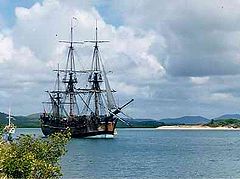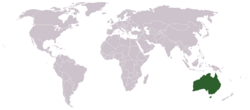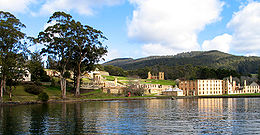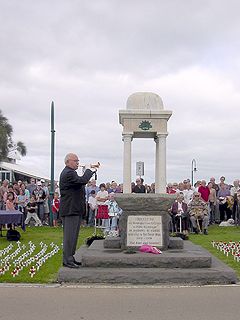Australia
- For other uses, see Australia (disambiguation).
| Commonwealth of Australia | ||||||
|---|---|---|---|---|---|---|
|
||||||
| Motto: none (formerly Advance Australia) | ||||||
| Anthem: Advance Australia Fair |
||||||
| Capital | Canberra | |||||
| Largest city | Sydney | |||||
| Official languages | English (de facto)1 | |||||
| Government | Const. monarchy | |||||
| Independence | ||||||
| Area | ||||||
| - | Total | 7,686,850 km² (6th) 2,967,909 sq mi |
||||
| - | Water (%) | 1 | ||||
| Population | ||||||
| - | September 2005 estimate | 20,406,800 (52nd) | ||||
| - | 2001 census | 18,972,350 | ||||
| GDP (PPP) | 2006 estimate | |||||
| - | Total | $674.97 billion (16th) | ||||
| - | Per capita | $32,686 (13th) | ||||
| Currency | Dollar (AUD) |
|||||
| Time zone | various2 (UTC+8–+10) | |||||
| - | Summer (DST) | various2 (UTC+8–+11) | ||||
| Internet TLD | .au | |||||
| Calling code | +61 | |||||
| 1English does not have de jure official status (source) 2There are some minor variations from these three time zones, see Time in Australia |
||||||
The Commonwealth of Australia, referred to as "the great southern land," has a name derived from the Latin Australis, meaning of the South. Legends of an "unknown land of the south" (terra australis incognita) date back to the Roman times. The name "Australia" was popularised by the 1814 work A Voyage to Terra Australis by the navigator Matthew Flinders who was the first person to circumnavigate Australia. Founded on English constitutional monarchy, Australia is also called "the lucky country," due to prosperity derived from its extensive mineral wealth.
Geography
Australia, pronounced “ors-trial-ya” in the twangy accent of that country's inhabitants, is a 7,686,850-square-kilometre landmass on the Indo-Australian Plate, slightly smaller than the continuous 48 states of the United States of America. It is surrounded by the Indian and Pacific oceans, and the Tasman Sea. Australia is separated from Asia by the Arafura and Timor seas. Neighbouring countries include Indonesia, East Timor and Papua New Guinea to the north; the Solomon Islands, Vanuatu and the French dependency of New Caledonia to the northeast; and New Zealand to the southeast.
Australia has a total 25,760 kilometres of coastline and claims an extensive Exclusive Economic Zone of 8,148,250 square kilometres without including the Australian Antarctic Territory.
The Great Barrier Reef, the world's largest coral reef, lies a short distance off the north-east coast and extends for over 2000 kilometres. The world's largest monolith, Mount Augustus, is located in Western Australia. At 2228 metres, Mount Kosciuszko on the Great Dividing Range is the highest mountain on the Australian mainland, although Mawson Peak on the remote Australian territory of Heard Island and McDonald Island is taller at 2745 metres.
Tectonic uplift of mountain ranges or clashes between tectonic plates occurred in Australia's early history, when it was still a part of Gondwana. Erosion has heavily weathered Australia's surface, making it one of the flattest countries in the world.
Much of Australia is desert or semi-arid. Only the south-east and south-west corners of the continent have a temperate climate and moderately fertile soil. The north, with a tropical climate, has rainforest, woodland, grassland and desert. Climate is influenced by ocean currents, including the El Niño southern oscillation, which brings periodic drought, and the seasonal tropical low pressure system that produces cyclones in northern Australia.
Rainfall is variable, with frequent droughts lasting several seasons. Duststorms can blanket a region or even several states.
The Great Artesian Basin, an important source of water for people and cattle in the parched outback, is the world's largest and deepest fresh water basin.
Natural hazards include cyclones along the northern coasts, severe thunderstorms, droughts and occasional floods as well as frequent bushfires.
Natural resources include: bauxite, coal, iron ore, copper, tin, gold, silver, uranium, nickel, tungsten, mineral sands, lead, zinc, diamonds, natural gas and petroleum. Arable land constitutes six percent of land use, permanent pastures make up 54 percent, forests and woodland cover 19 percent.
The capital city is Canberra, although the 2006 population of around 20.5 million is concentrated mainly in the large coastal cities of Sydney, Melbourne, Brisbane, Perth, and Adelaide.
Australia has a unique and diverse range of habitats, from alpine heaths to tropical rainforests,partly because of its long geographic isolation. About 85 percent of flowering plants, 84 percent of mammals, more than 45 percent of birds, and 89 percent of in-shore, temperate-zone fish are endemic.
Most Australian woody plant species are evergreen and many are adapted to fire and drought, including many eucalypts and acacias. Australia has a rich variety of endemic legume species that thrive in nutrient-poor soils because of their symbiosis with Rhizobia bacteria and mycorrhizal fungi. Well-known fauna include the platypus and echidna; a host of marsupials, including the koala, kangaroo, wombat; and birds such as the emu, and kookaburra. The dingo was introduced by Austronesian people that traded with indigenous Australians around 4000 B.C.E. Many plant and animal species became extinct after human settlement, including the Tasmanian Tiger.
History
The first Australians, the ancestors of the current indigenous Australians, arrived via land bridges and short sea-crossings from present-day Southeast Asia between 42,000 and 48,000 years ago. Most were hunter-gatherers, with a complex oral culture and spiritual values based on reverence for the land and a belief in a mythological “dreamtime.” The Torres Strait Islanders, ethnically Melanesian, who inhabited the Torres Strait Islands and parts of far-north Queensland, possess cultural practices that are different from the Aborigines.

Dutch navigator Willem Jansz sighted the coast of Cape York Peninsula in 1606, becoming the first European to do so. The Dutch charted the western and northern coastlines of what they called New Holland in the seventeenth century, but made no attempt at settlement. In 1770, James Cook sailed along and mapped the east coast of Australia, which he named New South Wales and claimed for Britain. This led to the establishment of a penal colony there.
The British Crown Colony of New South Wales started with the establishment of a settlement at Port Jackson by Captain Arthur Phillip on 26 January, 1788.
This date was to become Australia's national day, Australia Day. Van Diemen's Land, now known as Tasmania, was settled in 1803 and became a separate colony in 1825. The United Kingdom formally claimed the western part of Australia in 1829. Separate colonies were created from parts of New South Wales: South Australia in 1836, Victoria in 1851, and Queensland in 1859. The Northern Territory was founded in 1863 as part of the Province of South Australia. The transportation of convicts to Australia was phased out between 1840 and 1864.
The indigenous Australian population, estimated at about 350,000 at the time of European settlement, declined steeply for 150 years following settlement, because of infectious disease combined with forced re-settlement and cultural disintegration. The treatment of indigenous people is hotly debated within Australia. After the Australian referendum, 1967, the Federal government gained the power to implement policies and make laws with respect to Aborigines. Traditional ownership of land — native title — was not recognised until the High Court of Australia case Mabo v Queensland (No 2) overturned the notion of Australia as terra nullius at the time of European occupation.
A gold rush began in Australia in the early 1850s, and the Eureka Stockade rebellion in 1854 was an early expression of nationalist sentiment. Between 1855 and 1890, the six colonies individually gained responsible government. The Colonial Office in London retained control of foreign affairs, defence and international shipping. On 1 January 1901, the colonies federated and the Commonwealth of Australia was born as a Dominion of the British Empire. The Australian Capital Territory (ACT) was formed from New South Wales in 1911 to provide a location for the federal capital of Canberra (Melbourne was the capital from 1901 to 1927).
The Northern Territory was transferred from the control of the South Australian government to the Commonwealth in 1911. Australia willingly participated in World War I — in which 59,330 Australians lost their lives; many Australians regard the defeat of the Australian and New Zealand Army Corps (ANZACs) at the Battle of Gallipoli as the birth of the nation — its first major military action. Much like Gallipoli, the Kokoda Track Campaign is regarded by many as a nation-defining battle from World War II. A total of 40,400 Australians died in that war. Seventeen thousand served in the Korean War.
The Statute of Westminster 1931 formally ended most of the constitutional links between Australia and the United Kingdom, but Australia did not adopt the statute until 1942. The shock of the United Kingdom's defeat in Asia in 1942 and the threat of Japanese invasion caused Australia to turn to the United States as a new ally and protector. Since 1951, Australia has been a formal military ally of the US under the auspices of the ANZUS treaty. After World War II, Australia encouraged mass immigration from Europe; since the 1970s and the abolition of a White Australia policy, immigration from Asia and other parts of the world was encouraged. As a result, Australia's demography, culture and image of itself were transformed. The final constitutional ties between Australia and the United Kingdom ended in 1986 with the passing of the Australia Act 1986, ending judicial appeals to the UK Privy Council. Australian voters rejected a move to become a republic in 1999 by a 55 percent majority.
Politics

The Commonwealth of Australia is a constitutional monarchy and has a parliamentary system of government. Queen Elizabeth II is the Queen of Australia. The Queen is represented by the Governor-General of Australia, who was Maj. Gen. (Ret.) Michael Jeffery in 2006, at federal level, and by the governors at state level. The extensive powers given to the Governor-General are normally exercised only on the advice of the Prime Minister.
The parliament, or legislative branch of government, consists of an upper house, or senate, of 76 senators, and a lower house, or House of Representatives, of 150 members. Members of the lower house are elected from single-member constituencies, commonly known as “electorates.” These are allocated to states on the basis of population. Elections for both chambers are held every three years. The party with majority support in the House of Representatives forms Government, with its leader becoming Prime Minister.
The executive comprises the Queen, represented by the Governor General, the Prime Minister, who was John Howard in 2006, and a cabinet nominated by the Prime Minister.
The judiciary, the third branch of government, consists of the High Court, other federal courts and state courts, all of which became formally independent the Judicial Committee of the Privy Council in London when the Australia Act was passed in 1986. The legal system is based on English common law.
There are three main political parties: the Australian Labor Party, the Australian Liberal Party and the National Party. Independent members and several minor parties — including the Greens, Family First and the Democrats— have achieved representation mostly in upper houses. A Liberal/National Coalition led by Prime Minister John Howard has been in power since 1996
Australia consists of six states, two major mainland territories, and other minor territories. The states are New South Wales, Queensland, South Australia, Tasmania, Victoria and Western Australia. The two major mainland territories are the Northern Territory and the Australian Capital Territory. The state parliaments control hospitals, education, police, the judiciary, roads, public transport and local government. Each state and territory has its own parliament.
Australia has several minor territories. The federal government administers a separate area within New South Wales, the Jervis Bay Territory, as a naval base and sea port for the national capital. External territories include: Norfolk Island, Christmas Island, Cocos (Keeling) Islands, and the largely uninhabited Ashmore and Cartier Islands, Coral Sea Islands, Heard Island and McDonald Islands and the Australian Antarctic Territory.
Over recent decades, Australia's foreign relations have been driven by a close association with the United States, through the ANZUS pact and by a desire to develop relationships with Asia and the Pacific, particularly through the Association of Southeast Asian Nations (or ASEAN) and the Pacific Islands Forum. Australia is a member of the Commonwealth of Nations. Much of Australia's diplomatic energy is focused on international trade liberalisation. Australia is a founding member of the United Nations, and maintains an international aid program under which some 60 countries receive assistance. Australia's armed forces — the Australian Defence Force — comprise the Royal Australian Navy, the Australian Army, and the Royal Australian Air Force. All branches of the ADF have been involved in UN and regional peacekeeping (most recently in East Timor, the Solomon Islands and Sudan), disaster relief, and armed conflict, including the 2003 Invasion of Iraq. The forces, while numerically small compared to some in the region, consist of volunteers and are held in high regard as a well-trained force equipped with modern weapons.
Economy
Australia has a prosperous, Western-style mixed economy, with a per capita gross domestic product (GDP) slightly higher than those of the UK, Germany and France. The country was ranked third in the United Nations 2005 Human Development Index and sixth in The Economist worldwide quality-of-life index 2005. In recent years, the Australian economy has been resilient in the face of global economic downturn. Rising output in the domestic economy has been offsetting the global slump, and business and consumer confidence remains robust.
In 1983, the Labor Party, led by Prime Minister Bob Hawke and Treasurer Paul Keating, started the process of economic reform by floating the Australian dollar, and deregulating the financial system. Since 1996, the Howard government has continued reform, including the partial deregulation of the labour market and the privatisation of the communications industry. The introduction of a 10 percent goods and services tax, in July 2000, has slightly reduced a heavy reliance on personal and company income tax.
The Australian economy has not suffered a recession since the early 1990s. As of January 2006, unemployment was 5.3 percent with 10,034,500 persons employed. The service sector of the economy, including tourism, education, and financial services, comprises 69 percent of GDP. Agriculture and natural resources comprise 3 percent and 5 percent of GDP but contribute substantially to Australia's export performance. Australia's largest export markets include Japan 18.7 percent, People's Republic of China 9.2 percent, the United States 8.1 percent, South Korea 7.7 percent and New Zealand 7.4 percent. Export commodities include coal, gold, meat, wool, alumina, iron ore, wheat, machinery and transport equipment. Import commodities include machinery and transport equipment, computers and office machines, telecommunication equipment and parts; crude oil and petroleum products. Partners are the US, 14.8 percent, China 12.7 percent, Japan 11.8 percent, Germany 5.8 percent, Singapore 4.4 percent, and the UK 4.1 percent.
Demographics

Most of the estimated 20.4 million Australians are descended from nineteenth- and twentieth-century immigrants, from Great Britain and Ireland. Australia's population has quadrupled since the end of World War I, spurred by an ambitious immigration program. In 2001, the five largest groups of the 27.4 percent of Australians who were born overseas were from the United Kingdom, New Zealand, Italy, Vietnam and China. A policy of multiculturalism has been established to encourage and promote racial harmony.
The self-declared indigenous population — including Torres Strait Islanders, who are of Melanesian descent — was 410,003 (2.2 percent of the total population) in 2001, a significant increase from the 1976 census, which showed an indigenous population of 115,953. Indigenous Australians have higher rates of imprisonment and unemployment, lower levels of education and and shorter life expectancies. Perceived racial inequality is an ongoing political and human rights issue for Australians.
Australia is experiencing a demographic shift towards an older population, with more retirees and fewer people of working age. A large number of Australians (759,849 for the period 2002–03) live outside their home country.
English is the official language. Australian English, is the only language spoken in the home for around 80 percent of the population. Chinese is spoken by 2.1 percent, Italian by 1.9 percent and Greek, 1.4 percent. Many migrants are bilingual. There were between 200 and 300 Australian Aboriginal languages at the time of first European contact. Only 70 of these languages have survived, and all but 20 are now endangered. An indigenous language remains the main language for about 50,000 (0.02 percent) people. Australia has a sign language known as Auslan, which is the main language of about 6,500 deaf people.
Australia has no state religion. The 2001 census identified that 68 percent of Australians call themselves Christian: 27 percent identifying themselves as Roman Catholic and 21 percent as Anglican. Followers of non-Christian religions number 5 percent. A total of 16 percent were categorised as having no religion (which includes secular humanism, atheism, agnosticism and rationalism) and a further 12 percent declined to answer or made no clear response. Weekly attendance at church services is about 1.5 million, about 7.5 percent of the population.
School attendance is compulsory between the ages of six–15 years (16 years in South Australia and Tasmania, and 17 years in Western Australia), contributing to an adult literacy rate of 99 percent. Government grants have helped establish and fund Australia's 38 universities. Several private universities exist. There is a state-based system of vocational training colleges, known as Technical and Further Education Institutes, and many trades conduct apprenticeships for training new trades people. Approximately 58 percent of Australians between the ages of 25 and 64 have vocational or tertiary qualifications.
Culture

The basis of Australian culture until the mid-20th century was Anglo-Celtic, although distinctive Australian features had been evolving from the environment and Australian Aborigine culture. Over the past 50 years, Australian culture has been strongly influenced by American popular culture (particularly television and cinema), large-scale immigration from non-English-speaking countries, and Australia's Asian neighbours. The vigour and originality of the arts in Australia — films, opera, music, painting, theater, dance, and crafts — are achieving international recognition.
Australia has a long history of visual arts, starting with the cave and bark paintings of its indigenous peoples. From the time of European settlement, a common theme in Australian art has been the Australian landscape, seen in the works of Arthur Streeton, Arthur Boyd and Albert Namatjira, among others. The traditions of indigenous Australians are largely transmitted orally. Australian Aboriginal music, dance and Australian Aboriginal art influence contemporary Australian visual and performing arts. Many ballet and theatre companies receive funding through the federal government's Council for the Arts. There is a symphony orchestra in each capital city, and a national opera company, Opera Australia, first made prominent by the renowned diva Dame Joan Sutherland. Australian music includes classical, jazz, and many popular music genres.
Australian literature has also been influenced by the landscape; the works of writers such as Banjo Paterson and Henry Lawson captured the experience of the Australian bush. The character of colonial Australia, as embodied in early literature, shows and emphasis on egalitarianism, mateship, and anti-authoritarianism. In 1973, Patrick White was awarded the Nobel Prize in Literature, the only Australian to have achieved this.
Australian English is a major variety of the English language. Its grammar and spelling are largely based on those of British English, overlaid with a rich vernacular of unique lexical items and phrases, some of which have found their way into standard English.
Australia has two public broadcasters (the Australian Broadcasting Corporation| and Special Broadcasting Service), three commercial television networks, three pay TV services, and numerous public, non-profit television and radio stations. Australia's film industry has achieved critical and commercial successes. Each major city has daily newspapers, and there are two national daily newspapers, The Australian and The Australian Financial Review. According to Reporters Without Borders in 2005, Australia is in thirty first position on a list of countries ranked by freedom of the press, behind New Zealand (9th) and the United Kingdom (28th) but ahead of the United States. This ranking is due to the limited commercial media ownership — print media is under the control of either News Corporation or John Fairfax Holdings.
Sport is an important part of the culture, assisted by a climate that favours outdoor activities; 23.5 percent Australians over the age of 15 regularly participate in organised sport. Australia has particularly strong international teams in cricket, field hockey, netball, rugby league, rugby union, and performs well in cycling and swimming. Other popular sports include Australian rules football, football (soccer), and motor racing. Australia has participated in every summer Olympic Games of the modern era, and every Commonwealth Games. Australia has hosted the 1956 Summer Olympics and 2000 Summer Olympics, and has ranked among the top five medal-takers since 2000. Australia has also hosted the 1938 British Empire Games, 1962 British Empire and Commonwealth Games, 1982 Commonwealth Games and 2006 Commonwealth Games. Other major international events held regularly in Australia include the Australian Open, one of the four Grand Slam tennis tournaments, and the Formula One Australian Grand Prix. Corporate and government sponsorship of many sports and elite athletes is common in Australia. Televised sport is popular; some of the highest rating television programs include the summer Olympic Games and the grand finals of local and international football competitions.
Credits
New World Encyclopedia writers and editors rewrote and completed the Wikipedia article in accordance with New World Encyclopedia standards. This article abides by terms of the Creative Commons CC-by-sa 3.0 License (CC-by-sa), which may be used and disseminated with proper attribution. Credit is due under the terms of this license that can reference both the New World Encyclopedia contributors and the selfless volunteer contributors of the Wikimedia Foundation. To cite this article click here for a list of acceptable citing formats.The history of earlier contributions by wikipedians is accessible to researchers here:
The history of this article since it was imported to New World Encyclopedia:
Note: Some restrictions may apply to use of individual images which are separately licensed.












